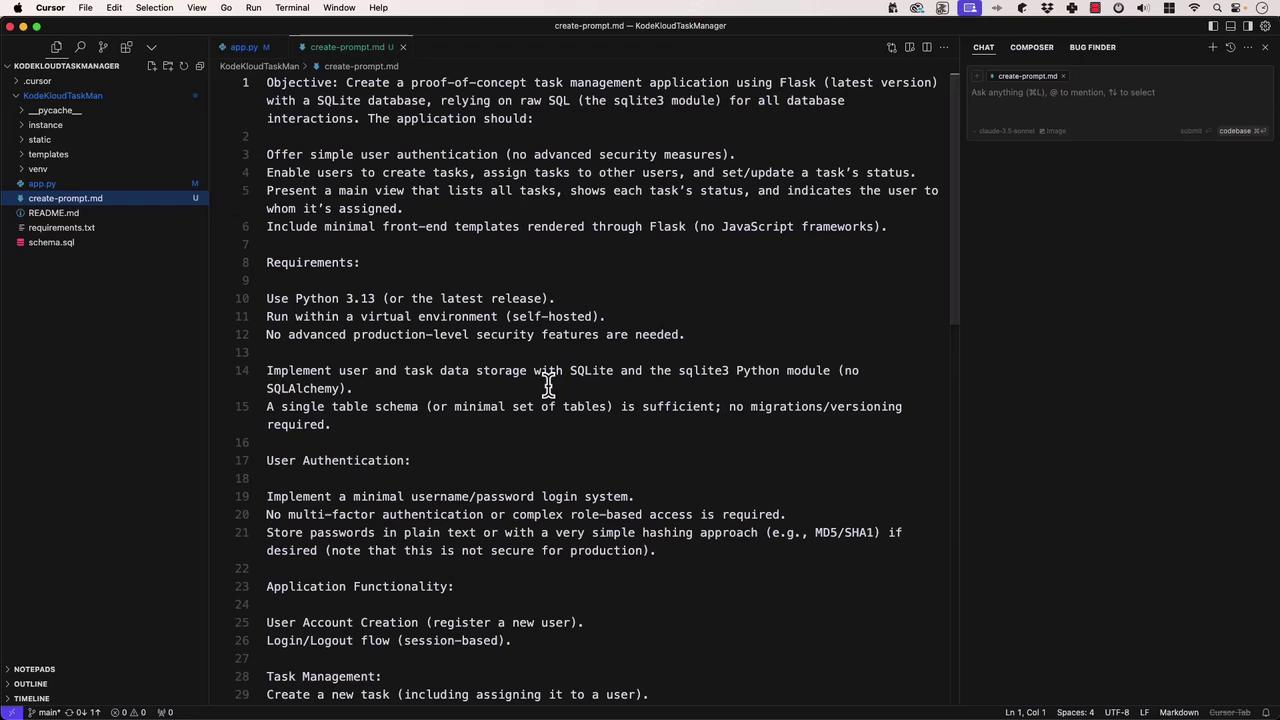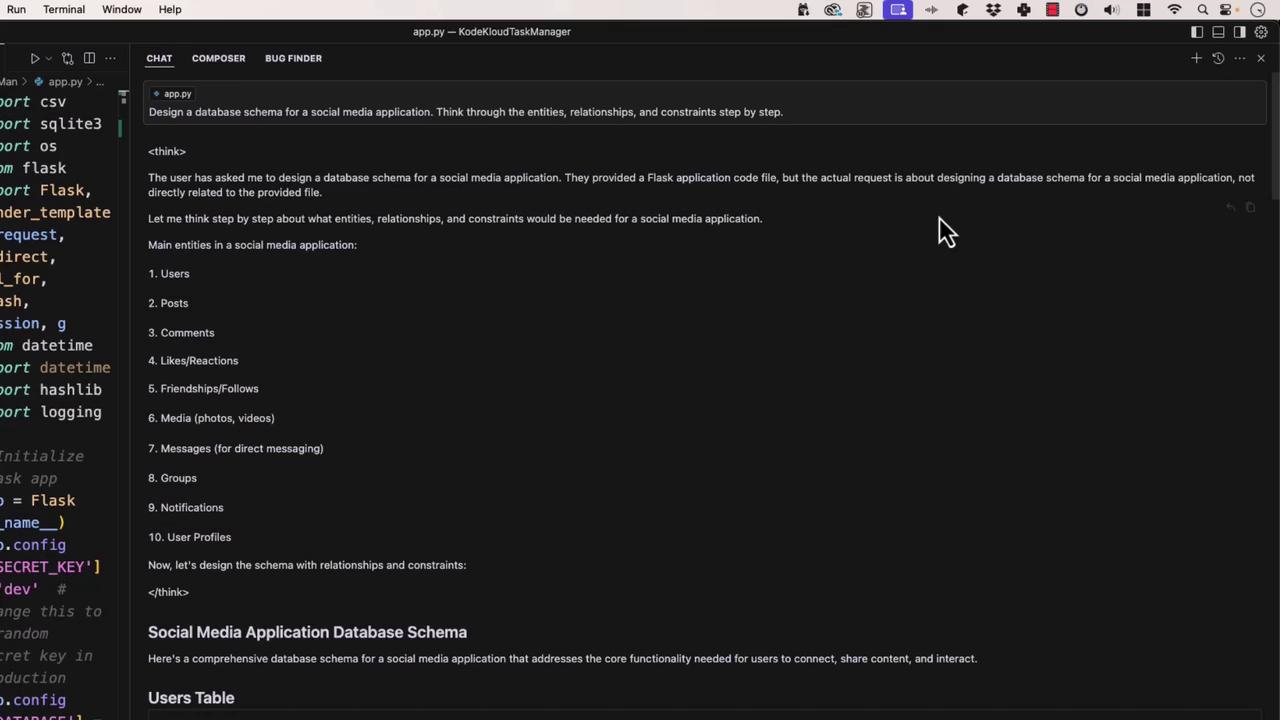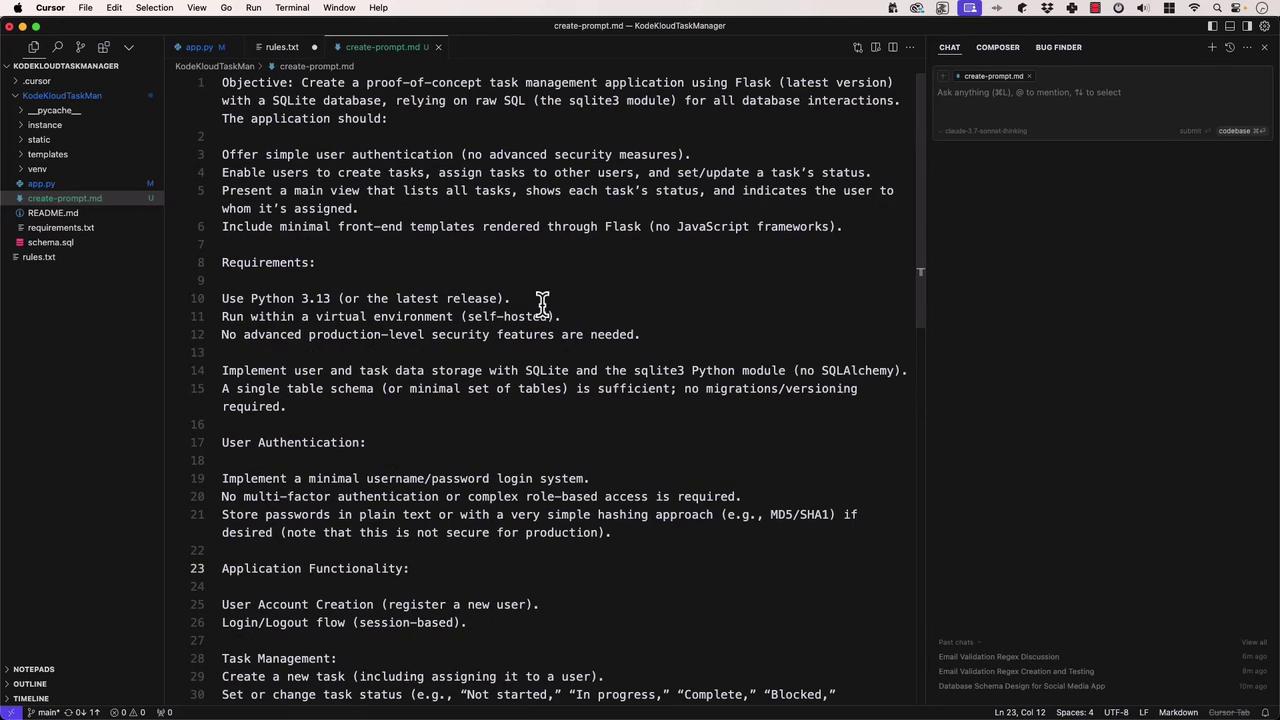Cursor AI
Mastering Autocompletion
Demo Essential Prompt Engineering
In this guide, you’ll learn how to craft effective prompts that steer large language models (LLMs) and tools like Cursor toward consistent, high-quality outputs. From precise requirements to creative exploration, we cover zero-shot, one-shot, few-shot, chain-of-thought, and self-consistency techniques to elevate your AI workflows.
Initial Context: Flask Task Manager Scaffold
Use this simple Flask application as a reference throughout our examples:
import csv
import sqlite3
import os
from flask import Flask, render_template, request, redirect, url_for, flash, session, g
from datetime import datetime
import hashlib
import logging
# Initialize Flask app
app = Flask(__name__)
app.config['SECRET_KEY'] = os.getenv('SECRET_KEY', 'dev') # Change in production
app.config['DATABASE'] = os.path.join(app.instance_path, 'task_manager.sqlite')
# Ensure the instance folder exists
os.makedirs(app.instance_path, exist_ok=True)
# Database connection function
def get_db():
if 'db' not in g:
g.db = sqlite3.connect(
app.config['DATABASE'],
detect_types=sqlite3.PARSE_DECLTYPES
)
g.db.row_factory = sqlite3.Row
return g.db
Warning
Always replace the default SECRET_KEY with a strong, unpredictable string before deploying to production.
Specific vs. Creative Prompts
Knowing when to lock down every detail versus when to let the model surprise you is crucial:
- Specific Prompts
Provide clear objectives, constraints, and examples. Ideal for scaffolding or boilerplate code that must meet exact requirements. - Creative Prompts
Offer a high-level request (e.g., “Build a task manager in Python”) and let the model explore solutions. Great for brainstorming or exploring alternatives.

Zero-Shot Prompting
Zero-shot means “no examples provided.” You simply state the task and expect the model to understand it.
Use case: Quick utility functions or well-defined algorithms.
Example prompt: “Write a function that calculates the Fibonacci sequence up to n terms.”
def fibonacci(n):
"""Return the first n numbers in the Fibonacci sequence."""
if n <= 0:
return []
sequence = [0, 1]
while len(sequence) < n:
sequence.append(sequence[-1] + sequence[-2])
return sequence
# Example usage:
print(fibonacci(10)) # [0, 1, 1, 2, 3, 5, 8, 13, 21, 34]
Note
Zero-shot is fast and straightforward, but your prompt must be unambiguous.
One-Shot Prompting
One-shot gives the model one example of the desired format, then asks it to generalize.
Prompt:
- Here’s a JavaScript function that sorts objects by a property:
function sortByProperty(array, property) { // ... } - Now write a function that finds the intersection of two arrays.
Model’s response:
function findIntersection(arr1, arr2) {
const set = new Set(arr1);
return arr2.filter(item => set.has(item));
}
// Deep comparison for objects
function findIntersectionDeep(arr1, arr2) {
return arr1.filter(item1 =>
arr2.some(item2 => JSON.stringify(item1) === JSON.stringify(item2))
);
}
Few-Shot Prompting (Viewport Prompting)
Few-shot provides multiple examples so the model can learn a pattern before continuing.
Examples:
describe('User Authentication', () => {
test('allows login with valid credentials', () => {
// ...
});
test('rejects login with invalid password', () => {
// ...
});
});
Prompt:
“Convert the requirement User session expires after 30 minutes of inactivity into a Jest test case.”
Model’s response:
describe('User Session Management', () => {
beforeEach(() => jest.useFakeTimers());
afterEach(() => jest.useRealTimers());
test('expires session after 30 minutes of inactivity', () => {
const session = createUserSession('testUser');
expect(session.isActive()).toBe(true);
jest.advanceTimersByTime(29 * 60 * 1000);
expect(session.isActive()).toBe(true);
jest.advanceTimersByTime(60 * 1000);
expect(session.isActive()).toBe(false);
});
});
Chain-of-Thought Prompting
Ask the model to “think aloud,” providing step-by-step reasoning before delivering a solution.
Prompt:
“Design a database schema for a social media app, reasoning through entities, relationships, and constraints.”

Generated SQL:
CREATE TABLE users ( ... );
CREATE TABLE posts ( ... );
-- and so on...
Self-Consistency Prompting
Generate multiple candidate solutions, evaluate each, and select the best. This boosts reliability for critical tasks.
Prompt:
“Write a regex matching valid email addresses, test it against these samples:
- [email protected]
- invalid@
- [email protected]
- @example.com”
import re
pattern = r'^[A-Za-z0-9._%+-]+@[A-Za-z0-9.-]+\.[A-Za-z]{2,}$'
tests = ['[email protected]', 'invalid@', '[email protected]', '@example.com']
for email in tests:
print(email, 'Valid' if re.match(pattern, email) else 'Invalid')
Advanced: Use the email-validator library for robust checks.
General Rules for Effective Prompting
- Be specific and clear.
- Provide context—code snippets, error logs, folder structure.
- Use structured formats: bullets, numbered steps, or tables.
- Specify output format (e.g., “Return TypeScript definitions”).
- Iterate and refine based on model feedback.

Prompting Techniques at a Glance
| Prompt Type | Description | Best For |
|---|---|---|
| Zero-Shot | No examples; rely on clear instructions | Simple, well-defined tasks |
| One-Shot | Single example to demonstrate desired output | Specific formatting or pattern |
| Few-Shot | Multiple examples to establish a pattern | Complex transformations |
| Chain-of-Thought | Step-by-step reasoning before the answer | Design, architecture, problem solving |
| Self-Consistency | Generate and compare several solutions | High-stakes or precision requirements |
With these prompt engineering strategies in your toolkit, you can direct LLMs to produce consistent, accurate, and well-structured results. Happy prompting!
Links and References
Watch Video
Watch video content